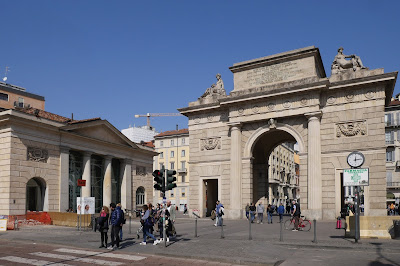Friday, 22 March 2019
Milan: Porta Nuova
We have just arrived in Milan and rather than visit the nearby Duomo (the plaza in front of it is jam-packed - it is a Saturday, when presumably the number of tourists is at a peak), we have headed out to Milan's newest attraction, the redevelopment of the Porta Nuova district. We leave the metro at Garibaldi and above is the view that confronts us: two sky scrapers with a plaza between them.
We head towards them from the station and are amused to be confronted by an old style tram: it seems out of place in this temple of modernism.
Before entering the plaza we continue along Corso Como to reach the Porta Nuova itself: a rather splendid arch flanked by a pair of pavilions. (I couldn't get them both in without cluttering the foreground with cars and people.) It dates from 1810 the old city walls when it seems that old city gates were torn down and new gates erected in a ring much further out.
From here, we headed back along Como and up a walkway leading to the plaza, with an intriguing building suggestive of the Hanging Gardens of Babylon in the background.
The plaza contains a mixture of shops and bars. What struck us most was that it seemed that most of the people there were Italians rather than tourists like us.
We now enjoyed a close up view of the Unicredit Tower. At 231m (758 ft) it is the tallest building in Italy (for comparison, the Shard in London is 306m high). The architect was César Pelli.
And then walked past this interesting low-rise structure, made of - or at least clad in - wood. It seemed to be empty and we wondered what its purpose would be.
At this point we spotted a sign on the boarding in front of the next area to be developed. It allowed us to discover that we were part of the way along a walking route through the development. This was great as it encouraged us to complete the route.
It seems that Porta Nuova has won an award for redevelopment schemes - and was being compared to the High Line in New York and the Las Ramblas in Barcelona. To be honest, we found this a bit far-fetched. The wonderful High Line, which we walked in 2015, presents itself as a linear park, while the original Rambla goes back a long time in history, while the early 19th century extension northwards from Plaza de Catalunya dates from the early 20th century and was part of a massive development called the Eixample, the extension.
Continuing along the route we passed on the left the pair of green buildings spotted earlier. They are very well named as the Bosco Verticale, or vertical forest. The towers, which are residential, were designed by Boeri Studio and opened in 2014. A remarkable sight.
We followed the walkway to its end. This is the view looking back with corporate towers on the right and houses for the rich on the left.
We retraced our steps and I took one final picture of a rectangular building with a sort exo-skeleton in wood and the Unicredit tower behind it.
Conditions: warm sunshine.
Distance: a couple of miles.
Rating: four and half stars. It is a very impressive development, despite some of my critical comments, and makes an interesting destination for tourists and locals alike. It perhaps just a bit over-hyped.
Subscribe to:
Post Comments (Atom)









No comments:
Post a Comment